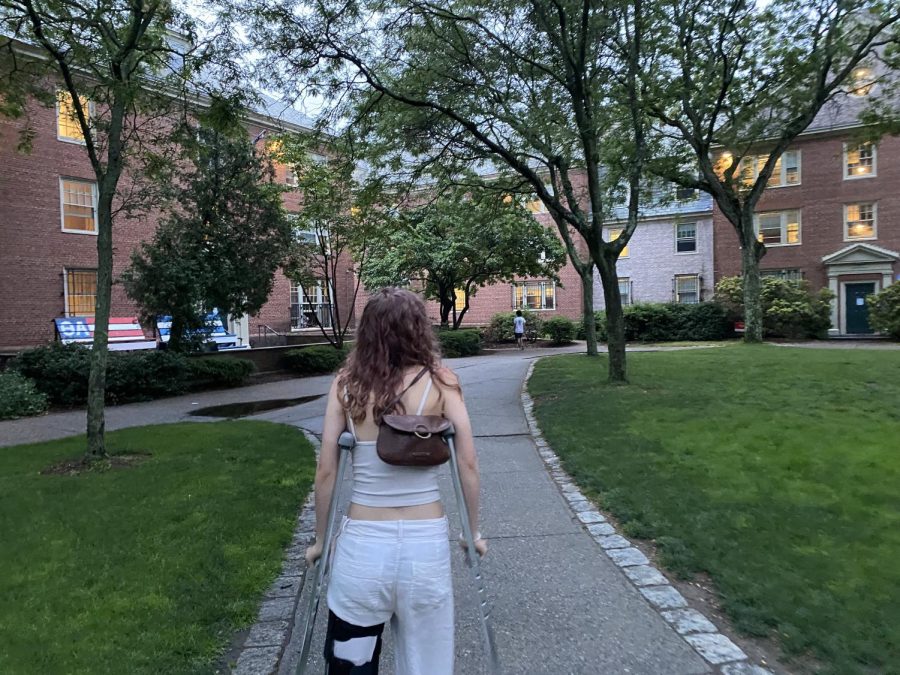Respecting Middle Eastern refugees and fighting the war on children

Dr. Katrin Jomaa is a professor at the University of Rhode Island of political science and philosophy with a focus in Middle East and Islam.
Ever since the terrorist attacks on September 11, 2001, the American people have become more interested in the Muslim and Middle Eastern immigrant population that lives and works within the United States.
Misrepresentations of Muslims as terrorists and enemies became a common occurrence in the American media. This misrepresentation allows for racist stereotypes to fester until many people view these lies as truth.
According to the FBI’s Uniform Crime Reports Program, the number of reported targeted attacks on the Muslim population has grown by more than five percent in the past ten years. This means that there are roughly 100-150 reported anti-Muslim hate crimes a year. This number is up from the 20-30 crimes reported prior to 2001.
In 2015, anti-Muslim crimes made up about 13 percent of religiously-motivated hate crimes, and two percent of all hate crimes in general.
One would think these numbers may discourage potential Muslim immigrants, but according to the Center of Immigration Studies, this is not the case.
In the October after 9/11, the Department of State received approximately 1.5 million more applications from the Middle East (not including Pakistan) for the visa lottery, a program that awards 50,000 green cards each year to randomly selected applicants.
This past September, the White House announced that the U.S. is preparing to take in at least 10,000 Syrian refugees starting on the Oct. 1, 2015. Prior to that announcement, U.S. had taken in less than 3,000 Middle Eastern refugees since war broke out in Syria in 2011.
White House spokesperson, Josh Earnest, reiterated that although the U.S. had not accepted as many refugees as other UN countries, the government has provided $4.0 billion in humanitarian aid to Syrian refugees fleeing violence in the Middle East.
Dr. Katrin Jomaa, a professor of political science and philosophy at URI with a focus on the Middle East and Islam said, “I think the US can do much better than that. I think the U.S. can resolve the problem in Syria, I don’t think taking more refugees is a solution…10,000, 20,000 that’s nothing,” Jomaa said. “I’m not saying that to undermine the importance of helping other people. I think the U.S. can do more. [We] are very much involved in the crisis in Syria. I think [we] can resort to diplomatic means to come to a solution.”
Dr. Jomaa is originally from the small European country of Lebanon and earned her bachelor’s degree in Mechanical Engineering in 1998 at American University in Cairo, Egypt. She came to the U.S. to earn her master’s degree in Material Science at the University of North Carolina-Chapel Hill in 2001. After earning her second degree, Jomaa returned to her home country of Lebanon to earn her master’s degree in Middle Eastern Studies at the American University of Beirut in 2005. Later, Jomaa earned her doctorate in Near Eastern Languages and Cultures at Indiana University Bloomington in 2012 before accepting a professorship at URI in 2013.
The United Nations predicts that in 2016, it will take a minimum of $7.7 billion to meet the needs of the most vulnerable Syrians who are fleeing to neighboring countries. Turkey, Lebanon, and Jordan expect refugees to arrive by traveling on foot. European countries such as Greece, England, and Germany expect the majority of the refugees to attempt to make the journey across the Aegean Sea.
To say that crossing the Aegean Sea is perilous is an understatement. According to the International Organization for Migration, more than 400 migrants having died making the journey so far this year. In September, when the lifeless body of Syrian toddler Aylan Kurdi washed up on a beach near Bodrum, Turkey, German Chancellor Angelica Merkel flew into action in an attempt to prevent as many immigrant deaths as possible.
In September, Chancellor Merkel called for UN countries to take in quotas of refugees in order to balance the mass influx streaming into certain nations. In 2016, Germany expects to receive some 800,000 asylum applications from refugees, which is nearly 790,000 more refugees than the U.S. is willing to take in.
The refugee crisis has been a hot topic in the 2016 US presidential primary debates. The candidates from both the Republican and Democratic parties have chosen stances on the controversial idea of allowing refugees into the country. Democratic nominees Bernie Sanders and Hillary Clinton have expressed sympathy for the refugees, both wanting to increase the amount of refugees allowed into the US from 10,000 to 65, 000 by the end of 2016. At a November campaign rally, Sanders said, “We will not turn our backs on the Syrian refugees.”
Donald Trump, the present frontrunner for the Republican presidential nomination, has made his position on refugees from both the Middle East and Mexico very clear. In a November interview with CNBC Trump said, “This could be one of the great Trojan horses.”
Similarly, in an interview with NBC News, Ben Carson, a former GOP presidential candidate, urged the US government to defund “ongoing federal programs that seek to resettle refugees and/or migrants from Syria into the United States, effective immediately.”
Other GOP candidates responded in a similar fashion.
“The likes of Donald Trump will always be there,” said Jomaa. “The problem is when somebody like that takes the stage and becomes a public figure…him and his likes will always be there, it just becomes sad when he gains supporters.”
What Trump, Carson, and others chose not to acknowledge is that every 15 seconds, a Syrian becomes a refugee and those witnessing the violence unfolding on the ground do not believe military action against the regime will bring relief.
Besides the five million reported refugees, MercyCorps estimated that another 6.6 million people are displaced inside war-torn Syria and are in desperate need of humanitarian aid.
Cramped together in tent communities, many Syrian fami lies feel cold and hungry every day. They consistently look for any opportunities that may provide permanent shelter. Violence, fights, robberies, rape, diseases, and death run rampant in the tent communities that the Syrian refugees inhabit.
In 2014, three years after the start of the Syrian War, Syria had its first confirmed case of polio since 1999. Syria was declared free of polio in 1999 by the World Health Organization (WHO), but in 2014, Syrian doctors working and living in the country and in refugee camps identified over 110 children with symptoms of polio. For every reported victim of the virus, there were many more unknowingly carrying and spreading the virus.
However, in January, Syrian healthcare reached an important milestone. Despite the challenges of providing healthcare in both refugee camps and isolated parts of war-torn countries, the country itself reached its second year without any confirmed cases of polio.
Despite this good news, children living in migrant camps still have much to be fearful for.
These children are forced to endure unimaginable conditions and find work to help support their families. UNICEF estimates that within the 7.5 million Syrian children in need of humanitarian aid, at least 60,000 currently hold temporary jobs in order to help their families. Many of these children are overworked and underpaid.
Countries like Turkey have been applauded by other UN nations for their willingness to accept millions of refugees and to accommodate their needs. However, as the number of immigrants rise within the country, child labor booms.
In Turkey alone, some children work as much as 60 hours per week in order to earn less than $200. In countries with a high immigrant population, there are “gray areas” when it comes to allowing refugees to work in sweatshops.
In Turkey, Syrians are required to obtain formal sponsorship in the form of a permit to be able to legally work. Permits are typically only granted to highly-skilled refugees, and, as a result, the Regional Refugee and Resilience Plan Organization estimates that more than two million Syrians are not legally authorized to work in Turkey. This frequently causes the financial burden to fall on the children in Syrian families.
Syrian children who are able to work in Turkey are often the breadwinners in their families and face significant amounts of stress. Such stress is incomprehensible for many American high school students. This amount of stress coupled with memories of harsh warfare are enough to concern a large number of child psychologists. Such psychologists fear for the mental health and well-being of Syria’s future generations.
UNICEF states that, out of the 5.5+ million children affected by warfare, over two million will need some kind of psychological assistance to overcome their mental trauma.
A 2002 study done by researchers from the University of Missouri-Columbia found that, out of the 800 children interviewed who experienced the 1994 Siege of Sarajevo, 94 percent were diagnosed with post-traumatic stress disorder (PTSD). The symptoms of PTSD, which are depression, anxiety, fear, anger, frustration, and self-destructive behavior, have been found in many Syrian children.
According to UNICEF, older children and teenagers are struggling in different ways. A survey of children in Za’atari refugee camp found that a third of all children there displayed aggressive behavior and self-harm.
“Invisible wounds are undermining the capacity of tomorrow’s parents, teachers, and leaders,”said a 2014 UNICEF report on the psychological impact of warfare on the children of Syria. “This could carry grave, long-term implications for the entire region, undermining the foundations on which strong societies are built.”
Along with the emotional and physical trauma that Syrian children have experienced, the burden of learning the new language of their host country and several age-specific stressors, such as puberty, can heavily impact their mental functioning and development.
“Despite the risk for mental health sequelae after exposure to the unimaginable hardship and trauma associated with war, the literature and clinical experience suggest that war-affected children demonstrate tremendous resilience,” stated the American Psychological Association (APA) task force in a report on the psychosocial effects of war on children and families who are refugees from armed conflict and who reside in the United States.
In spite of all the hardships they face, the refugee children from Syria have remained hopeful about the idea that they might someday return home or that they might find a permanent home in another country. For instance, the Ghazala family recently became the first Syrian refugees to arrive in Rhode Island.
“[It’s important to remember that] Syrians don’t want to leave their homes,” said Dr. Jomaa. “They want to stay and rebuild. They are trying to flee the country because of the poor situation.” Jomaa added that it is equally important to accept these refugees as humans who have experienced tragedy and not to view them in the manner that the media portrays them.
“Americans and Muslim Americans need to know each other… on a personal level,” said Dr. Jomaa. “This will help a lot to wash away these stereotypes.”
Fast Facts:
● Syria’s civil war is often considered the worst humanitarian crisis of our time. Half of the country’s pre-war population — more than 11 million people — have been killed or forced to flee their homes.
● The U.N. estimates that 6.6 million people are internally displaced. When you also consider refugees, more than half of the country’s pre-war population of 23 million people needs urgent humanitarian assistance, whether they still remain in the country or have escaped across the borders.
● More than 4 million Syrians have registered or are awaiting registration with the United Nations’ High Commission of Refugees. ● Germany and Sweden lead the UN countries in accepting 165,000 refugees, combined.
● As the result of a ceasefire that lasted for two weeks, February 17, 2016 marked the date when the first humanitarian aid started to trickle in. Hundreds of truckloads of supplies have been allowed through regions controlled by both government forces and certain militant groups. Such goods have reached and saved more than 100,000 civilians.
● The reported number of child refugees under 5 years of age from Syria is 425,000.
● In all of this conflict, it is crucial to remember that all Middle Eastern countries are not in crisis. Many are not affected by the influx of refugees and the Syrian Civil War.
● On March 7, 2016 , the United Nations said that Turkey’s plan to resettle one Syrian refugee in Europe for each one returned to Turkey was “consistent with European law.”
●Despite the statements by the UN, individual countries have taken action to close the “Balkan Route,” which is a migrant route that starts in Turkey, runs through Serbia, Austria, and Hungary, and ends in France and Germany.
Your donation will support the student journalists of North Kingstown High School. Your contribution will allow us to distribute a print edition of the Current Wave to all students, as well as enter journalism competitions.




